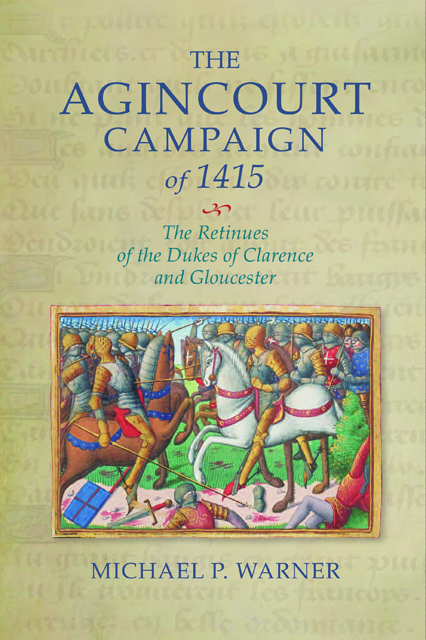Book contents
- Frontmatter
- Contents
- Lists of Tables and Charts
- List of Figures
- Acknowledgements
- Abbreviations
- Introduction
- 1 Before the Campaign
- 2 The Muster Rolls of the 1415 Expedition
- 3 Clarence’s and Gloucester’s 1415 Retinues
- 4 The Sub-Retinue Captains
- 5 During the Campaign
- 6 After the Campaign
- Conclusion
- Appendices
- Bibliography
- Index
- Warfare in History
- Frontmatter
- Contents
- Lists of Tables and Charts
- List of Figures
- Acknowledgements
- Abbreviations
- Introduction
- 1 Before the Campaign
- 2 The Muster Rolls of the 1415 Expedition
- 3 Clarence’s and Gloucester’s 1415 Retinues
- 4 The Sub-Retinue Captains
- 5 During the Campaign
- 6 After the Campaign
- Conclusion
- Appendices
- Bibliography
- Index
- Warfare in History
Summary
This story shall the good man teach his son;
And Crispin Crispian shall ne’er go by,
From this day to the ending of the world,
But we in it shall be remembered;
We few, we happy few, we band of brothers.
Shakespeare, Henry V, IV.3.55–60.On 25 July 1415, Sir John Dabridgecourt, a stalwart supporter of the House of Lancaster, sealed his lengthy and detailed will. At over 60, Sir John was once again heading to war, for what would be at least his ninth military campaign. Within his will, he instructed that if he were to die on the impending expedition, his body was to be buried ‘ubicumque Deus disposuerit’ (wherever God chooses). Sir John, we may presume, was drawn out of his comfortable retirement by the prospect of serving on the first military campaign to France commanded by a king of England in person since Edward III’s 1359 expedition. Like men from all across England and Wales, Sir John travelled from his home in Derbyshire to Southampton, where he would have found the town and its surrounding villages teeming with soldiers in July–August 1415. King Henry V’s huge army, which numbered over 12,000 strong, was gathering in preparation for its muster and embarkation to France.
Henry V’s army, like all armies of that period, was composed of a multiplicity of individual ‘bands’, or retinues, of men-at-arms and archers. The army was recruited through the system of indenture, whereby retinue captains and sub-captains indented with the Crown to raise a contracted number of soldiers for a certain period, in return for a specified wage. This study focuses on the two largest retinues, those commanded by the king’s brothers: Thomas, duke of Clarence, and Humphrey, duke of Gloucester. On Monday, 29 April 1415, the dukes indented – affixed their seals to legal contracts – to recruit, respectively, 960 and 800 men, collectively 15% of Henry’s army. The men they recruited, such as Dabridgecourt and his sub-retinue, who served under Clarence, assembled at pre-assigned locations around Southampton. We are incredibly fortunate, because we know the names of those who mustered under the dukes as both retinues have complete surviving muster rolls, created before embarkation.
- Type
- Chapter
- Information
- The Agincourt Campaign of 1415The Retinues of the Dukes of Clarence and Gloucester, pp. 1 - 9Publisher: Boydell & BrewerPrint publication year: 2021

